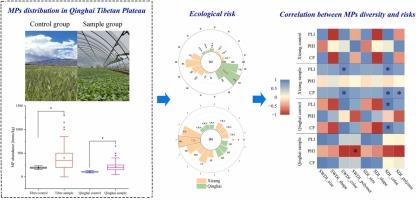Occurrence characteristics and ecological impact of agricultural soil microplastics in the Qinghai Tibetan Plateau, China
IF 12.2
1区 环境科学与生态学
Q1 ENGINEERING, ENVIRONMENTAL
引用次数: 0
Abstract
Plastic mulch is widely recognized as a significant contributor to microplastics (MPs) pollution in agricultural soil. However, its direct impact on remote areas with low population density remains uncertain due to multiple pollution sources. This study aims to investigate MPs pollution and its risks regarding agricultural soil in the Qinghai Tibetan Plateau (QTP) in China. The results revealed that soil samples from the study area exhibited a range of MPs abundance, varying from 16.67 to 950 items/kg, with the highest average abundance observed in Chengguan district (CG) soil samples (611.11 items/kg). Polyethylene terephthalate (PET), polypropylene (PP), and polyethylene (PE) were identified as the predominant components of MPs in farmland soil. Furthermore, significantly higher levels of MPs were found in the facility agriculture soil compared to the control soil. Diversity and risk of MPs in different regions and cultivation conditions were significantly different. According to the employed risk assessment models, agricultural soil demonstrated a relatively high polymer risk (47% of areas classified as level III). In addition to being influenced by exogenous factors, the diversity of MPs also plays an intrinsic role in regulating the risk of MPs pollution. This study contributes to an enhanced comprehension of the issue of MPs pollution in QTP farmland soil, providing valuable empirical evidence and theoretical underpinning for the development of efficacious control strategies.

中国青藏高原农田土壤微塑料的出现特征及生态影响
塑料地膜被广泛认为是造成农业土壤中微塑料(MPs)污染的重要因素。然而,由于污染源众多,其对人口密度低的偏远地区的直接影响仍不确定。本研究旨在调查青藏高原农田土壤中的微塑料污染及其风险。结果表明,研究区土壤样品中 MPs 的丰度范围在 16.67 至 950 微克/千克之间,其中城关区土壤样品中 MPs 的平均丰度最高(611.11 微克/千克)。聚对苯二甲酸乙二醇酯(PET)、聚丙烯(PP)和聚乙烯(PE)被确定为农田土壤中 MPs 的主要成分。此外,与对照土壤相比,设施农业土壤中 MPs 的含量明显更高。不同地区和不同种植条件下 MPs 的多样性和风险存在显著差异。根据所采用的风险评估模型,农田土壤的聚合物风险相对较高(47% 的区域被列为三级)。除了受外源因素的影响外,高分子化合物的多样性在调节高分子化合物污染风险方面也发挥着内在作用。这项研究有助于加深对 QTP 农田土壤中 MPs 污染问题的理解,为制定有效的控制策略提供了宝贵的经验证据和理论依据。
本文章由计算机程序翻译,如有差异,请以英文原文为准。
求助全文
约1分钟内获得全文
求助全文
来源期刊

Journal of Hazardous Materials
工程技术-工程:环境
CiteScore
25.40
自引率
5.90%
发文量
3059
审稿时长
58 days
期刊介绍:
The Journal of Hazardous Materials serves as a global platform for promoting cutting-edge research in the field of Environmental Science and Engineering. Our publication features a wide range of articles, including full-length research papers, review articles, and perspectives, with the aim of enhancing our understanding of the dangers and risks associated with various materials concerning public health and the environment. It is important to note that the term "environmental contaminants" refers specifically to substances that pose hazardous effects through contamination, while excluding those that do not have such impacts on the environment or human health. Moreover, we emphasize the distinction between wastes and hazardous materials in order to provide further clarity on the scope of the journal. We have a keen interest in exploring specific compounds and microbial agents that have adverse effects on the environment.
 求助内容:
求助内容: 应助结果提醒方式:
应助结果提醒方式:


